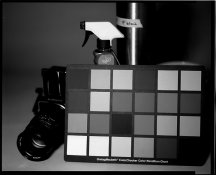Congrats, Michael, to both yourself and your students; those images are wonderful.
Regarding Efke's Direct Positive paper, I worked with it last summer. I was able to get some good images, some of which I posted here several months ago (they're on another computer else I'd repost them again now); suffice it to say that I had to preflash the bejeezus out of the paper to get a reasonably normal image in bright daylight with some semblance of midtones.
IIRC, whereas my "normal" preflashing time for grade 2 paper negatives is 10 seconds using my lighting setup, with the Efke paper I used a preflash time around 30 seconds. And near this 30 second time small adjustments in preflash time had large effects on the overall exposure and contrast of the image.
Also, I rated the Efke paper at a personal exposure index of 1, rather than the 3 I apply to my grade 2 paper negatives.
Earlier, PE said: "You brought up an important point. You have overexposed to fight contrast. Well, if you overexpose and either under develop to get lower contrast or develop normally, you will be talking about at least 2 stops which is about ISO 6 or thereabouts. This will reduce the contrast nicely, but it will not center a tonal scale at normal development.
All of my photos include the MacBeth Checker and have the neutral scale centered with Dmin on one side and Dmax on the other, and they were given normal development, no under or over, and no flash.
I think that all of this is important. I am trying to get at the full tonal range. To actually do this with a paper, I suggest a grade 0 or grade 1 graded paper."
Perhaps all I'm doing is over-exposing and under-developing the paper to get a good tonal range from daylit scenes. That makes the meaning of film speed less useful, of course.
And I use graded paper rather than multigrade; I think the use of multigrade while trying to determine a useful personal exposure index just confuses the issue.
My experience with using paper as an in-camera negative is that I don't treat the exposure and development the same as when using paper as a print media. For instance, I do not desire a negative where the scene's highlights appear almost paper black on the negative; this would be the equivalent of blowing out the highlights on film. Neither do I desire to develop the paper fully to "completion"; that would be the equivalent of over developing the bejeezus out of film. A good paper negative has highlight details that are dark gray at most, nowhere near approaching maximum paper black; and shadow detail just below paper white, like feathery traces of tone. The overall appearance of such a negative is a very low contrast, nothing like the dramatic contrast one can achieve with the print.
The approach to using paper as a sort of film is very film-like. And the approach to using paper as a print media is, well, much different from film. So I suppose the debate over what's the optimal exposure index for paper is really about finding a way to systematize the exposure of paper negatives using light meters whose spectral sensitivity doesn't match the paper at all. It's cobbling together a method of working with a material in ways it was not designed to work, using tools that aren't intended for that application.
I still don't understand the divergence of experience we seem to have regarding reciprocity of paper, however:
"No, I suspect reciprocity perhaps in these experiments. IDK. Paper is generally not intended for being used at much below 1/2" or much about about 90" or thereabouts. I would think that we are all outside of this range in one way or another. IDK."
I've found consistent results while using grade 2 Arista paper in pinhole cameras where the exposure times range from 30 seconds to 5 minutes; and equally consistent exposures in glass lens cameras using shutter speed of fractions of seconds. In all cases my personal exposure index of 3 seems to work well.
I find paper to be a wonderful medium to work with, especially in large format, glass lens cameras. The resulting contact prints are easy and fun to work with.
~Joe




 Was hoping to create some 'photographic monotypes' with the larger cameras.
Was hoping to create some 'photographic monotypes' with the larger cameras.
